Advanced Financial Accounting Report: Enron Case Study Analysis
VerifiedAdded on 2023/06/05
|12
|3057
|351
Report
AI Summary
This report delves into advanced financial accounting, examining mark-to-market accounting, special purpose entities (SPEs), and stock options compensation, using the Enron case as a primary example. It explains how mark-to-market accounting, also known as fair value accounting, can misrepresent a company's financial performance, and how Enron's misuse of SPEs, along with stock options compensation, contributed to its downfall. The report further explores the elements of financial statements, focusing on measurement methods like historical cost, current costs, net realizable value, and present value, with Woolworths Group as a case study for the application of historical cost methodology. The analysis highlights the importance of accurate financial reporting and the impact of accounting practices on investor decisions and company valuations.
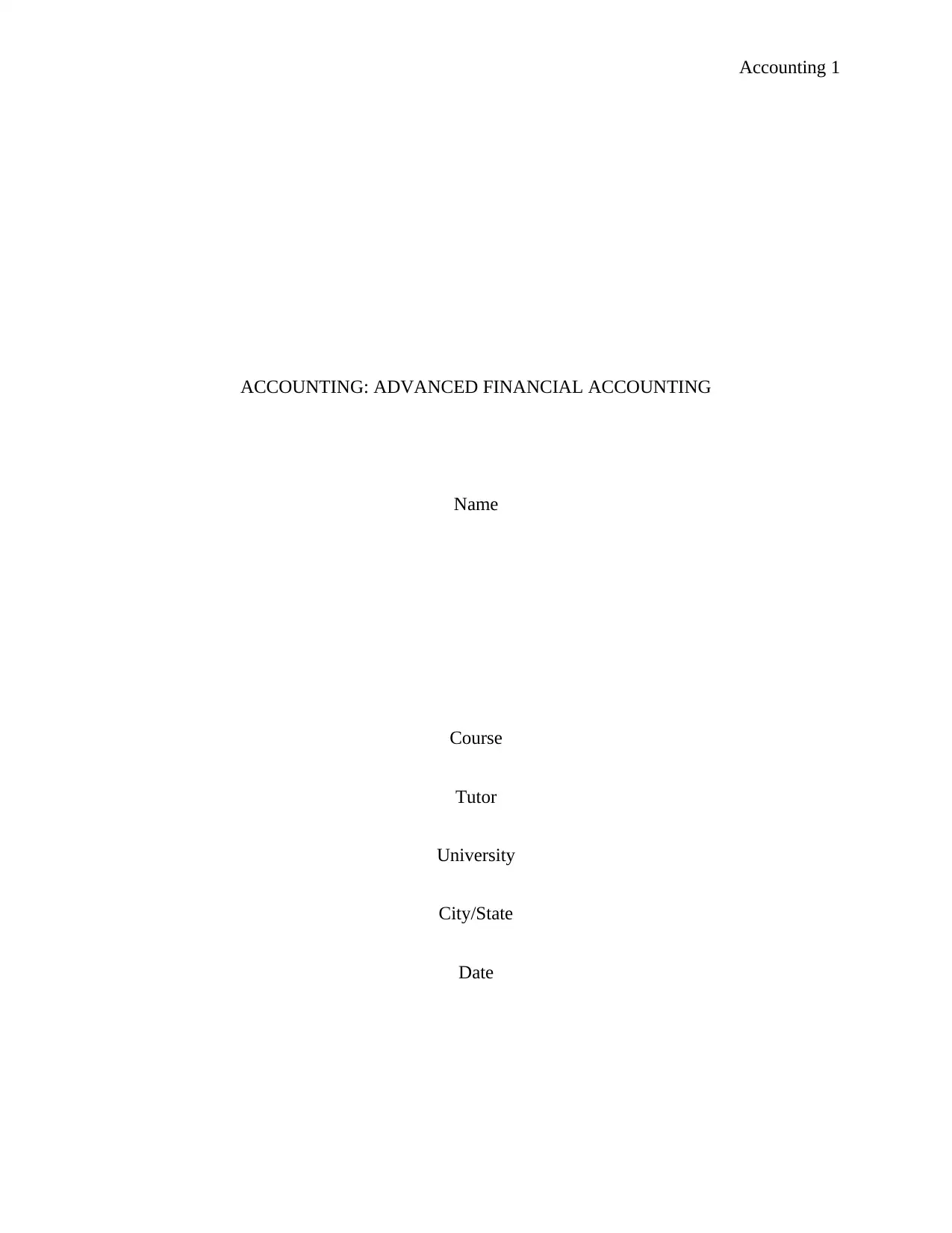
Accounting 1
ACCOUNTING: ADVANCED FINANCIAL ACCOUNTING
Name
Course
Tutor
University
City/State
Date
ACCOUNTING: ADVANCED FINANCIAL ACCOUNTING
Name
Course
Tutor
University
City/State
Date
Secure Best Marks with AI Grader
Need help grading? Try our AI Grader for instant feedback on your assignments.
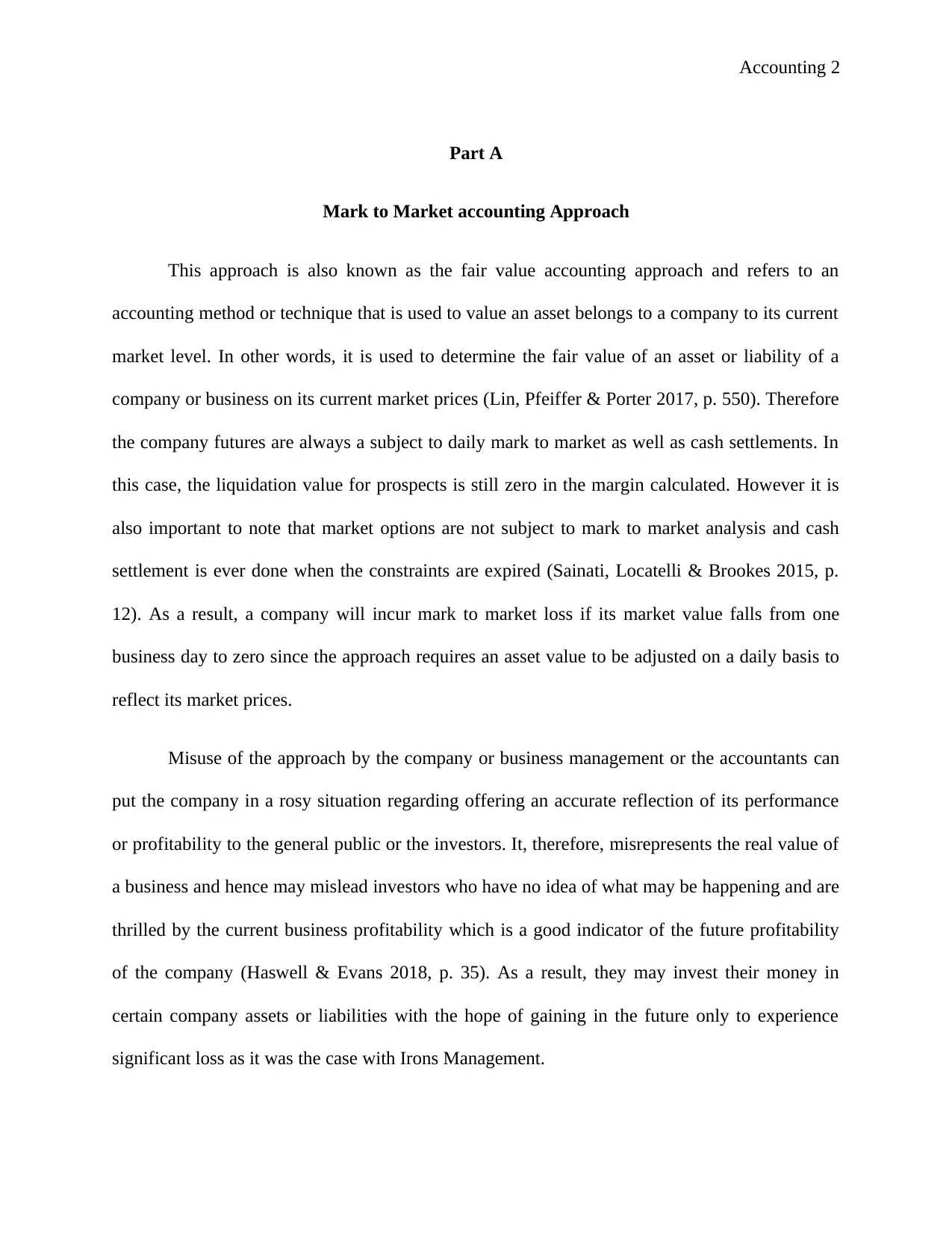
Accounting 2
Part A
Mark to Market accounting Approach
This approach is also known as the fair value accounting approach and refers to an
accounting method or technique that is used to value an asset belongs to a company to its current
market level. In other words, it is used to determine the fair value of an asset or liability of a
company or business on its current market prices (Lin, Pfeiffer & Porter 2017, p. 550). Therefore
the company futures are always a subject to daily mark to market as well as cash settlements. In
this case, the liquidation value for prospects is still zero in the margin calculated. However it is
also important to note that market options are not subject to mark to market analysis and cash
settlement is ever done when the constraints are expired (Sainati, Locatelli & Brookes 2015, p.
12). As a result, a company will incur mark to market loss if its market value falls from one
business day to zero since the approach requires an asset value to be adjusted on a daily basis to
reflect its market prices.
Misuse of the approach by the company or business management or the accountants can
put the company in a rosy situation regarding offering an accurate reflection of its performance
or profitability to the general public or the investors. It, therefore, misrepresents the real value of
a business and hence may mislead investors who have no idea of what may be happening and are
thrilled by the current business profitability which is a good indicator of the future profitability
of the company (Haswell & Evans 2018, p. 35). As a result, they may invest their money in
certain company assets or liabilities with the hope of gaining in the future only to experience
significant loss as it was the case with Irons Management.
Part A
Mark to Market accounting Approach
This approach is also known as the fair value accounting approach and refers to an
accounting method or technique that is used to value an asset belongs to a company to its current
market level. In other words, it is used to determine the fair value of an asset or liability of a
company or business on its current market prices (Lin, Pfeiffer & Porter 2017, p. 550). Therefore
the company futures are always a subject to daily mark to market as well as cash settlements. In
this case, the liquidation value for prospects is still zero in the margin calculated. However it is
also important to note that market options are not subject to mark to market analysis and cash
settlement is ever done when the constraints are expired (Sainati, Locatelli & Brookes 2015, p.
12). As a result, a company will incur mark to market loss if its market value falls from one
business day to zero since the approach requires an asset value to be adjusted on a daily basis to
reflect its market prices.
Misuse of the approach by the company or business management or the accountants can
put the company in a rosy situation regarding offering an accurate reflection of its performance
or profitability to the general public or the investors. It, therefore, misrepresents the real value of
a business and hence may mislead investors who have no idea of what may be happening and are
thrilled by the current business profitability which is a good indicator of the future profitability
of the company (Haswell & Evans 2018, p. 35). As a result, they may invest their money in
certain company assets or liabilities with the hope of gaining in the future only to experience
significant loss as it was the case with Irons Management.
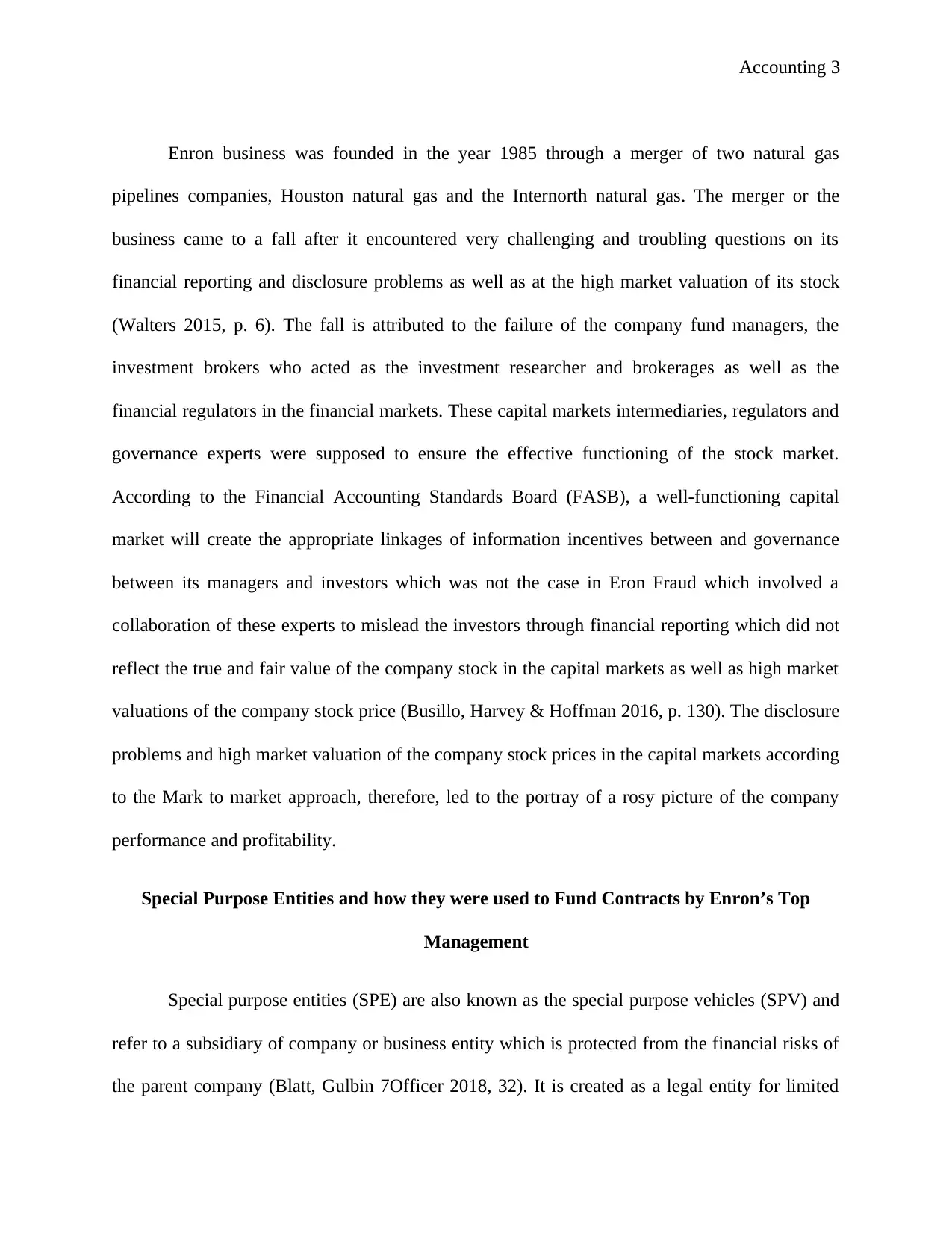
Accounting 3
Enron business was founded in the year 1985 through a merger of two natural gas
pipelines companies, Houston natural gas and the Internorth natural gas. The merger or the
business came to a fall after it encountered very challenging and troubling questions on its
financial reporting and disclosure problems as well as at the high market valuation of its stock
(Walters 2015, p. 6). The fall is attributed to the failure of the company fund managers, the
investment brokers who acted as the investment researcher and brokerages as well as the
financial regulators in the financial markets. These capital markets intermediaries, regulators and
governance experts were supposed to ensure the effective functioning of the stock market.
According to the Financial Accounting Standards Board (FASB), a well-functioning capital
market will create the appropriate linkages of information incentives between and governance
between its managers and investors which was not the case in Eron Fraud which involved a
collaboration of these experts to mislead the investors through financial reporting which did not
reflect the true and fair value of the company stock in the capital markets as well as high market
valuations of the company stock price (Busillo, Harvey & Hoffman 2016, p. 130). The disclosure
problems and high market valuation of the company stock prices in the capital markets according
to the Mark to market approach, therefore, led to the portray of a rosy picture of the company
performance and profitability.
Special Purpose Entities and how they were used to Fund Contracts by Enron’s Top
Management
Special purpose entities (SPE) are also known as the special purpose vehicles (SPV) and
refer to a subsidiary of company or business entity which is protected from the financial risks of
the parent company (Blatt, Gulbin 7Officer 2018, 32). It is created as a legal entity for limited
Enron business was founded in the year 1985 through a merger of two natural gas
pipelines companies, Houston natural gas and the Internorth natural gas. The merger or the
business came to a fall after it encountered very challenging and troubling questions on its
financial reporting and disclosure problems as well as at the high market valuation of its stock
(Walters 2015, p. 6). The fall is attributed to the failure of the company fund managers, the
investment brokers who acted as the investment researcher and brokerages as well as the
financial regulators in the financial markets. These capital markets intermediaries, regulators and
governance experts were supposed to ensure the effective functioning of the stock market.
According to the Financial Accounting Standards Board (FASB), a well-functioning capital
market will create the appropriate linkages of information incentives between and governance
between its managers and investors which was not the case in Eron Fraud which involved a
collaboration of these experts to mislead the investors through financial reporting which did not
reflect the true and fair value of the company stock in the capital markets as well as high market
valuations of the company stock price (Busillo, Harvey & Hoffman 2016, p. 130). The disclosure
problems and high market valuation of the company stock prices in the capital markets according
to the Mark to market approach, therefore, led to the portray of a rosy picture of the company
performance and profitability.
Special Purpose Entities and how they were used to Fund Contracts by Enron’s Top
Management
Special purpose entities (SPE) are also known as the special purpose vehicles (SPV) and
refer to a subsidiary of company or business entity which is protected from the financial risks of
the parent company (Blatt, Gulbin 7Officer 2018, 32). It is created as a legal entity for limited
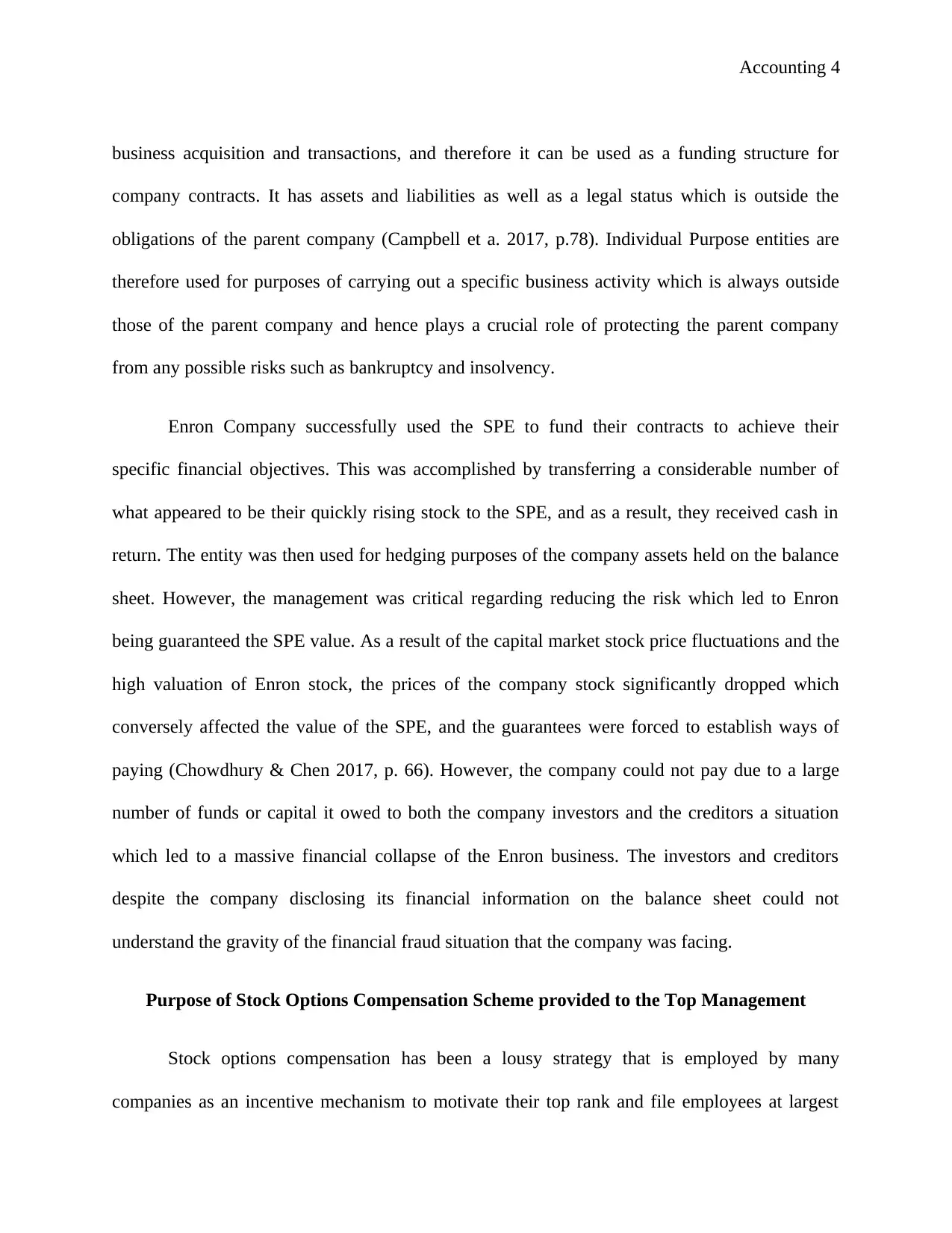
Accounting 4
business acquisition and transactions, and therefore it can be used as a funding structure for
company contracts. It has assets and liabilities as well as a legal status which is outside the
obligations of the parent company (Campbell et a. 2017, p.78). Individual Purpose entities are
therefore used for purposes of carrying out a specific business activity which is always outside
those of the parent company and hence plays a crucial role of protecting the parent company
from any possible risks such as bankruptcy and insolvency.
Enron Company successfully used the SPE to fund their contracts to achieve their
specific financial objectives. This was accomplished by transferring a considerable number of
what appeared to be their quickly rising stock to the SPE, and as a result, they received cash in
return. The entity was then used for hedging purposes of the company assets held on the balance
sheet. However, the management was critical regarding reducing the risk which led to Enron
being guaranteed the SPE value. As a result of the capital market stock price fluctuations and the
high valuation of Enron stock, the prices of the company stock significantly dropped which
conversely affected the value of the SPE, and the guarantees were forced to establish ways of
paying (Chowdhury & Chen 2017, p. 66). However, the company could not pay due to a large
number of funds or capital it owed to both the company investors and the creditors a situation
which led to a massive financial collapse of the Enron business. The investors and creditors
despite the company disclosing its financial information on the balance sheet could not
understand the gravity of the financial fraud situation that the company was facing.
Purpose of Stock Options Compensation Scheme provided to the Top Management
Stock options compensation has been a lousy strategy that is employed by many
companies as an incentive mechanism to motivate their top rank and file employees at largest
business acquisition and transactions, and therefore it can be used as a funding structure for
company contracts. It has assets and liabilities as well as a legal status which is outside the
obligations of the parent company (Campbell et a. 2017, p.78). Individual Purpose entities are
therefore used for purposes of carrying out a specific business activity which is always outside
those of the parent company and hence plays a crucial role of protecting the parent company
from any possible risks such as bankruptcy and insolvency.
Enron Company successfully used the SPE to fund their contracts to achieve their
specific financial objectives. This was accomplished by transferring a considerable number of
what appeared to be their quickly rising stock to the SPE, and as a result, they received cash in
return. The entity was then used for hedging purposes of the company assets held on the balance
sheet. However, the management was critical regarding reducing the risk which led to Enron
being guaranteed the SPE value. As a result of the capital market stock price fluctuations and the
high valuation of Enron stock, the prices of the company stock significantly dropped which
conversely affected the value of the SPE, and the guarantees were forced to establish ways of
paying (Chowdhury & Chen 2017, p. 66). However, the company could not pay due to a large
number of funds or capital it owed to both the company investors and the creditors a situation
which led to a massive financial collapse of the Enron business. The investors and creditors
despite the company disclosing its financial information on the balance sheet could not
understand the gravity of the financial fraud situation that the company was facing.
Purpose of Stock Options Compensation Scheme provided to the Top Management
Stock options compensation has been a lousy strategy that is employed by many
companies as an incentive mechanism to motivate their top rank and file employees at largest
Secure Best Marks with AI Grader
Need help grading? Try our AI Grader for instant feedback on your assignments.

Accounting 5
companies to work harder. As a result, the companies end up paying them heavily despite the
financial health of the company (Markham 2015, p. 18). Enron’s compensation strategy,
therefore, followed such practices of rewarding the top executives with incentives which cost the
company millions of dollars which were provided in the form of stock options. These stock
options provide a guarantee to the senior employees of the right to buy a certain amount of
company shares at a predetermined share price (Diebold & Yılmaz 2014, p. 126). As a strategy,
it can be very manipulative from the top management who despite the collapse of the business
they were to be compensated and hence the failure of the Enron’s business. As part of their
financial fraud mechanism, the high inherent incentives were among the factors which
encouraged the top executives of Enron business to present very misleading financial
information to their shareholders to inflate the stock prices to cash their stock options and walk
away with millions of dollars from the company.
Part B
Elements of Financial statements Measurement as defined by International FRS conceptual
Framework
The financial report is essential documents for any company and is used to portray of
reflecting the business transactions or activities of a company by merely grouping them into
different classes according to their economic characteristics (Gherai & Balaciu 2015, p. 36). The
levels formed are therefore known as the elements of financial statements. Thus for any
company, these elements can either be directly related to the financial position of the company or
the balance sheet, or they can be connected to straight to the company performance as reflected
in the income statement. The most identifiable elements related to the balance sheet are the
companies to work harder. As a result, the companies end up paying them heavily despite the
financial health of the company (Markham 2015, p. 18). Enron’s compensation strategy,
therefore, followed such practices of rewarding the top executives with incentives which cost the
company millions of dollars which were provided in the form of stock options. These stock
options provide a guarantee to the senior employees of the right to buy a certain amount of
company shares at a predetermined share price (Diebold & Yılmaz 2014, p. 126). As a strategy,
it can be very manipulative from the top management who despite the collapse of the business
they were to be compensated and hence the failure of the Enron’s business. As part of their
financial fraud mechanism, the high inherent incentives were among the factors which
encouraged the top executives of Enron business to present very misleading financial
information to their shareholders to inflate the stock prices to cash their stock options and walk
away with millions of dollars from the company.
Part B
Elements of Financial statements Measurement as defined by International FRS conceptual
Framework
The financial report is essential documents for any company and is used to portray of
reflecting the business transactions or activities of a company by merely grouping them into
different classes according to their economic characteristics (Gherai & Balaciu 2015, p. 36). The
levels formed are therefore known as the elements of financial statements. Thus for any
company, these elements can either be directly related to the financial position of the company or
the balance sheet, or they can be connected to straight to the company performance as reflected
in the income statement. The most identifiable elements related to the balance sheet are the
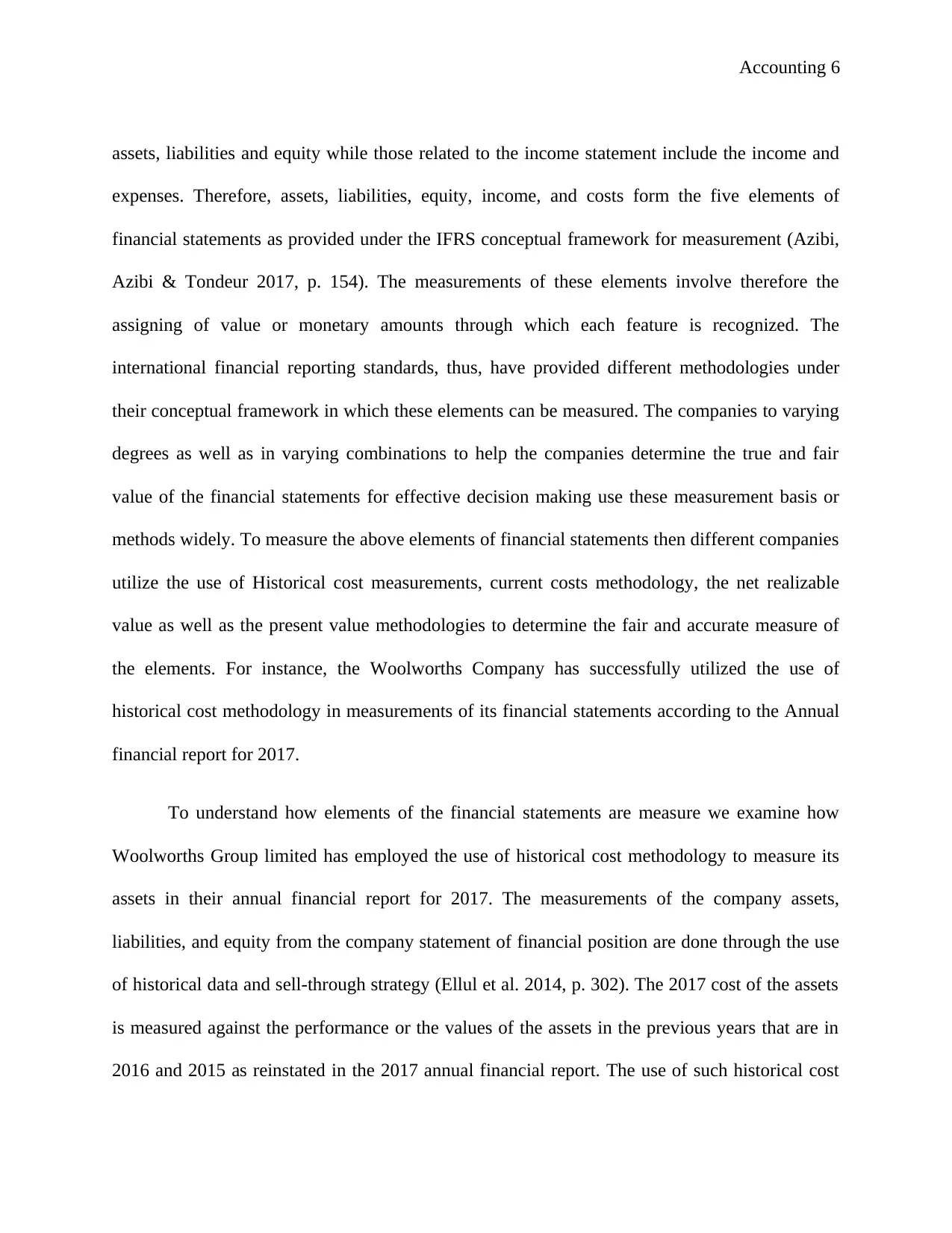
Accounting 6
assets, liabilities and equity while those related to the income statement include the income and
expenses. Therefore, assets, liabilities, equity, income, and costs form the five elements of
financial statements as provided under the IFRS conceptual framework for measurement (Azibi,
Azibi & Tondeur 2017, p. 154). The measurements of these elements involve therefore the
assigning of value or monetary amounts through which each feature is recognized. The
international financial reporting standards, thus, have provided different methodologies under
their conceptual framework in which these elements can be measured. The companies to varying
degrees as well as in varying combinations to help the companies determine the true and fair
value of the financial statements for effective decision making use these measurement basis or
methods widely. To measure the above elements of financial statements then different companies
utilize the use of Historical cost measurements, current costs methodology, the net realizable
value as well as the present value methodologies to determine the fair and accurate measure of
the elements. For instance, the Woolworths Company has successfully utilized the use of
historical cost methodology in measurements of its financial statements according to the Annual
financial report for 2017.
To understand how elements of the financial statements are measure we examine how
Woolworths Group limited has employed the use of historical cost methodology to measure its
assets in their annual financial report for 2017. The measurements of the company assets,
liabilities, and equity from the company statement of financial position are done through the use
of historical data and sell-through strategy (Ellul et al. 2014, p. 302). The 2017 cost of the assets
is measured against the performance or the values of the assets in the previous years that are in
2016 and 2015 as reinstated in the 2017 annual financial report. The use of such historical cost
assets, liabilities and equity while those related to the income statement include the income and
expenses. Therefore, assets, liabilities, equity, income, and costs form the five elements of
financial statements as provided under the IFRS conceptual framework for measurement (Azibi,
Azibi & Tondeur 2017, p. 154). The measurements of these elements involve therefore the
assigning of value or monetary amounts through which each feature is recognized. The
international financial reporting standards, thus, have provided different methodologies under
their conceptual framework in which these elements can be measured. The companies to varying
degrees as well as in varying combinations to help the companies determine the true and fair
value of the financial statements for effective decision making use these measurement basis or
methods widely. To measure the above elements of financial statements then different companies
utilize the use of Historical cost measurements, current costs methodology, the net realizable
value as well as the present value methodologies to determine the fair and accurate measure of
the elements. For instance, the Woolworths Company has successfully utilized the use of
historical cost methodology in measurements of its financial statements according to the Annual
financial report for 2017.
To understand how elements of the financial statements are measure we examine how
Woolworths Group limited has employed the use of historical cost methodology to measure its
assets in their annual financial report for 2017. The measurements of the company assets,
liabilities, and equity from the company statement of financial position are done through the use
of historical data and sell-through strategy (Ellul et al. 2014, p. 302). The 2017 cost of the assets
is measured against the performance or the values of the assets in the previous years that are in
2016 and 2015 as reinstated in the 2017 annual financial report. The use of such historical cost
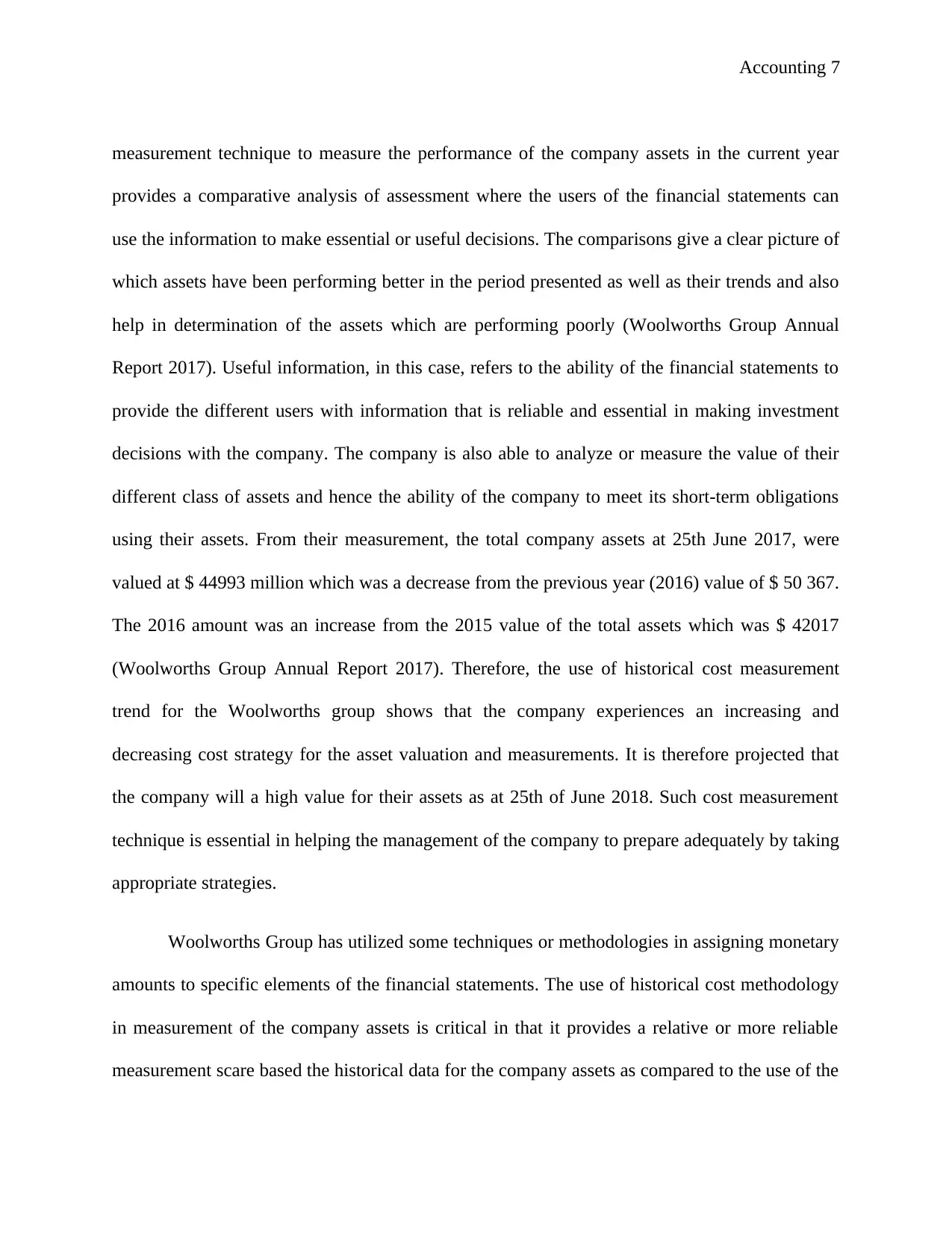
Accounting 7
measurement technique to measure the performance of the company assets in the current year
provides a comparative analysis of assessment where the users of the financial statements can
use the information to make essential or useful decisions. The comparisons give a clear picture of
which assets have been performing better in the period presented as well as their trends and also
help in determination of the assets which are performing poorly (Woolworths Group Annual
Report 2017). Useful information, in this case, refers to the ability of the financial statements to
provide the different users with information that is reliable and essential in making investment
decisions with the company. The company is also able to analyze or measure the value of their
different class of assets and hence the ability of the company to meet its short-term obligations
using their assets. From their measurement, the total company assets at 25th June 2017, were
valued at $ 44993 million which was a decrease from the previous year (2016) value of $ 50 367.
The 2016 amount was an increase from the 2015 value of the total assets which was $ 42017
(Woolworths Group Annual Report 2017). Therefore, the use of historical cost measurement
trend for the Woolworths group shows that the company experiences an increasing and
decreasing cost strategy for the asset valuation and measurements. It is therefore projected that
the company will a high value for their assets as at 25th of June 2018. Such cost measurement
technique is essential in helping the management of the company to prepare adequately by taking
appropriate strategies.
Woolworths Group has utilized some techniques or methodologies in assigning monetary
amounts to specific elements of the financial statements. The use of historical cost methodology
in measurement of the company assets is critical in that it provides a relative or more reliable
measurement scare based the historical data for the company assets as compared to the use of the
measurement technique to measure the performance of the company assets in the current year
provides a comparative analysis of assessment where the users of the financial statements can
use the information to make essential or useful decisions. The comparisons give a clear picture of
which assets have been performing better in the period presented as well as their trends and also
help in determination of the assets which are performing poorly (Woolworths Group Annual
Report 2017). Useful information, in this case, refers to the ability of the financial statements to
provide the different users with information that is reliable and essential in making investment
decisions with the company. The company is also able to analyze or measure the value of their
different class of assets and hence the ability of the company to meet its short-term obligations
using their assets. From their measurement, the total company assets at 25th June 2017, were
valued at $ 44993 million which was a decrease from the previous year (2016) value of $ 50 367.
The 2016 amount was an increase from the 2015 value of the total assets which was $ 42017
(Woolworths Group Annual Report 2017). Therefore, the use of historical cost measurement
trend for the Woolworths group shows that the company experiences an increasing and
decreasing cost strategy for the asset valuation and measurements. It is therefore projected that
the company will a high value for their assets as at 25th of June 2018. Such cost measurement
technique is essential in helping the management of the company to prepare adequately by taking
appropriate strategies.
Woolworths Group has utilized some techniques or methodologies in assigning monetary
amounts to specific elements of the financial statements. The use of historical cost methodology
in measurement of the company assets is critical in that it provides a relative or more reliable
measurement scare based the historical data for the company assets as compared to the use of the
Paraphrase This Document
Need a fresh take? Get an instant paraphrase of this document with our AI Paraphraser
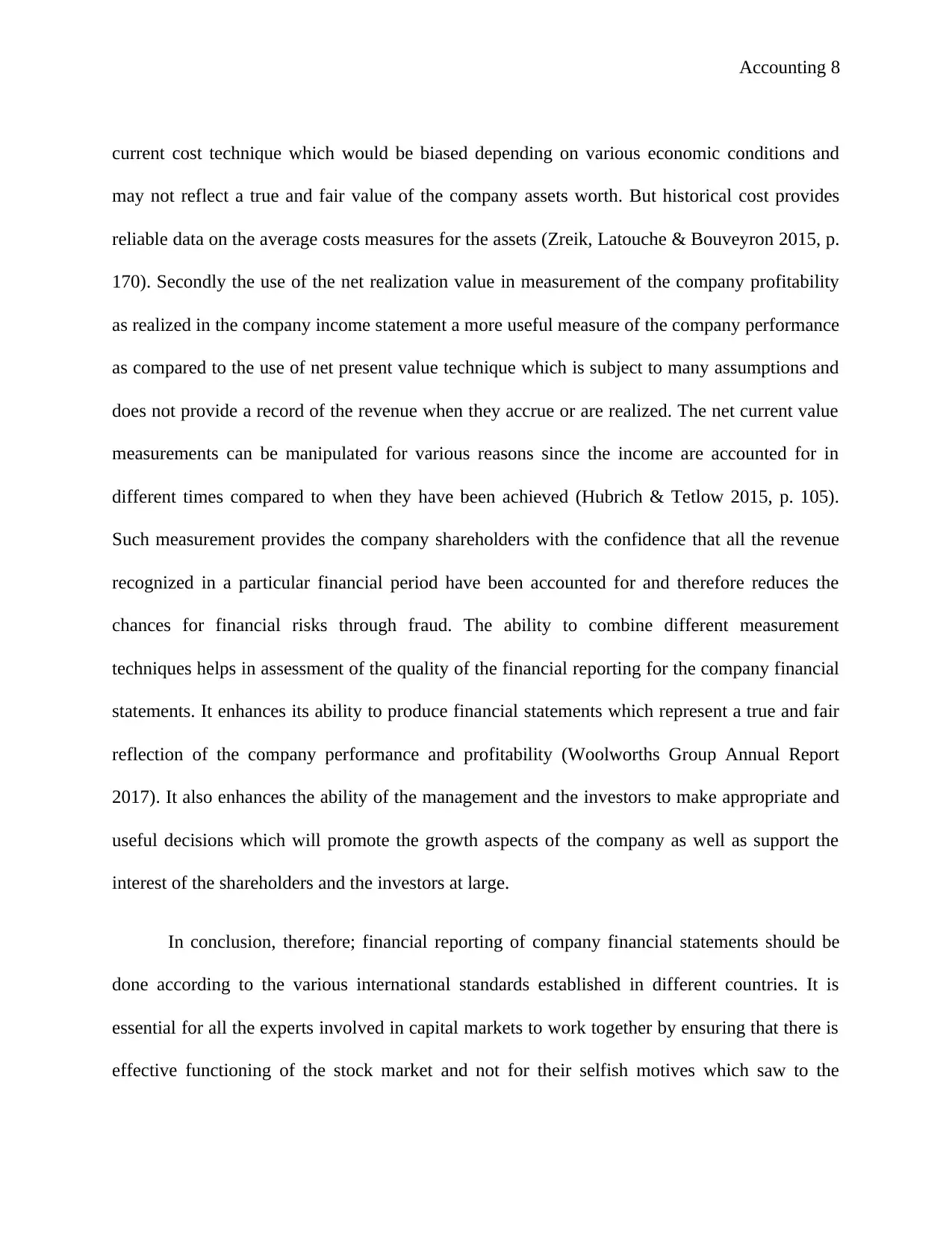
Accounting 8
current cost technique which would be biased depending on various economic conditions and
may not reflect a true and fair value of the company assets worth. But historical cost provides
reliable data on the average costs measures for the assets (Zreik, Latouche & Bouveyron 2015, p.
170). Secondly the use of the net realization value in measurement of the company profitability
as realized in the company income statement a more useful measure of the company performance
as compared to the use of net present value technique which is subject to many assumptions and
does not provide a record of the revenue when they accrue or are realized. The net current value
measurements can be manipulated for various reasons since the income are accounted for in
different times compared to when they have been achieved (Hubrich & Tetlow 2015, p. 105).
Such measurement provides the company shareholders with the confidence that all the revenue
recognized in a particular financial period have been accounted for and therefore reduces the
chances for financial risks through fraud. The ability to combine different measurement
techniques helps in assessment of the quality of the financial reporting for the company financial
statements. It enhances its ability to produce financial statements which represent a true and fair
reflection of the company performance and profitability (Woolworths Group Annual Report
2017). It also enhances the ability of the management and the investors to make appropriate and
useful decisions which will promote the growth aspects of the company as well as support the
interest of the shareholders and the investors at large.
In conclusion, therefore; financial reporting of company financial statements should be
done according to the various international standards established in different countries. It is
essential for all the experts involved in capital markets to work together by ensuring that there is
effective functioning of the stock market and not for their selfish motives which saw to the
current cost technique which would be biased depending on various economic conditions and
may not reflect a true and fair value of the company assets worth. But historical cost provides
reliable data on the average costs measures for the assets (Zreik, Latouche & Bouveyron 2015, p.
170). Secondly the use of the net realization value in measurement of the company profitability
as realized in the company income statement a more useful measure of the company performance
as compared to the use of net present value technique which is subject to many assumptions and
does not provide a record of the revenue when they accrue or are realized. The net current value
measurements can be manipulated for various reasons since the income are accounted for in
different times compared to when they have been achieved (Hubrich & Tetlow 2015, p. 105).
Such measurement provides the company shareholders with the confidence that all the revenue
recognized in a particular financial period have been accounted for and therefore reduces the
chances for financial risks through fraud. The ability to combine different measurement
techniques helps in assessment of the quality of the financial reporting for the company financial
statements. It enhances its ability to produce financial statements which represent a true and fair
reflection of the company performance and profitability (Woolworths Group Annual Report
2017). It also enhances the ability of the management and the investors to make appropriate and
useful decisions which will promote the growth aspects of the company as well as support the
interest of the shareholders and the investors at large.
In conclusion, therefore; financial reporting of company financial statements should be
done according to the various international standards established in different countries. It is
essential for all the experts involved in capital markets to work together by ensuring that there is
effective functioning of the stock market and not for their selfish motives which saw to the
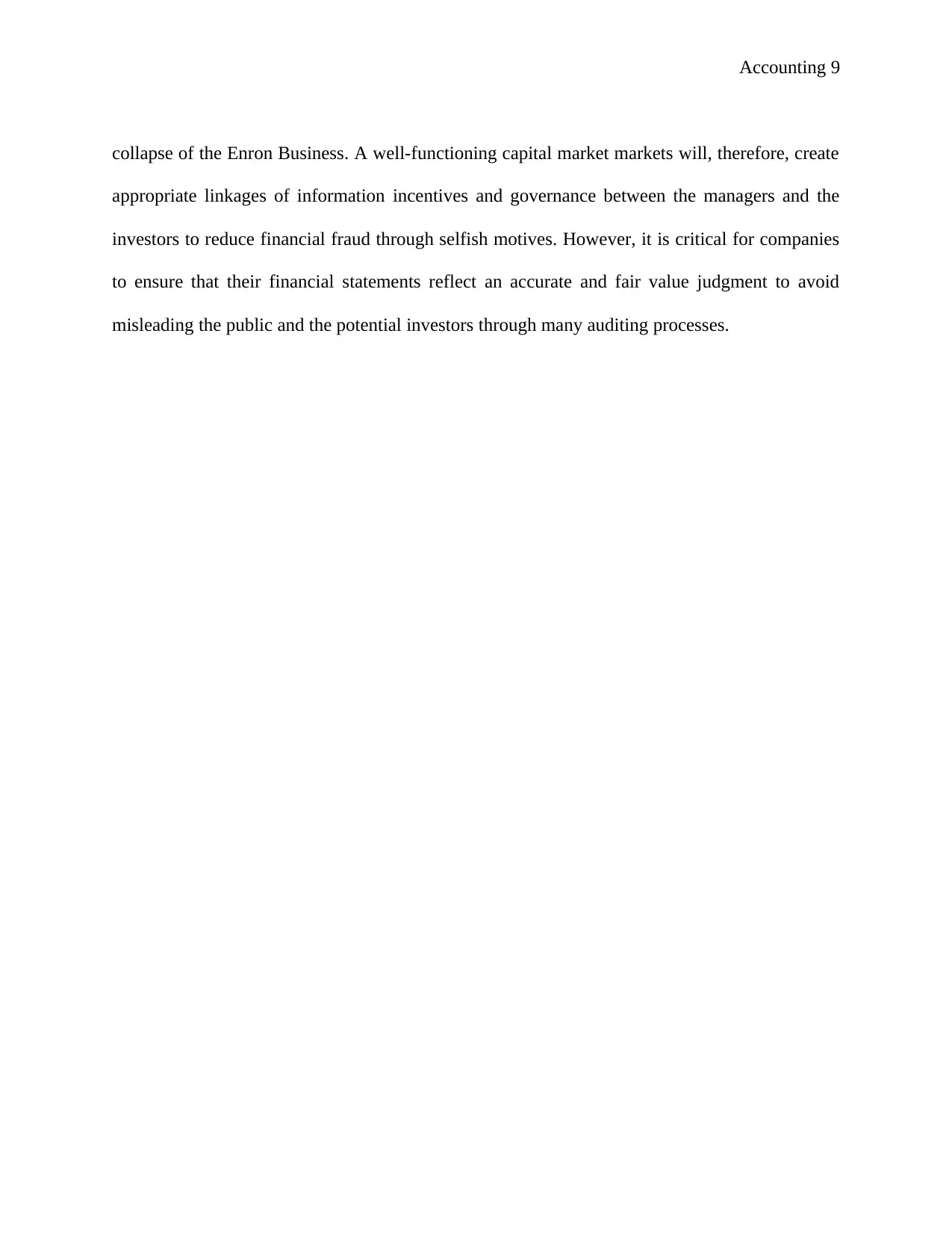
Accounting 9
collapse of the Enron Business. A well-functioning capital market markets will, therefore, create
appropriate linkages of information incentives and governance between the managers and the
investors to reduce financial fraud through selfish motives. However, it is critical for companies
to ensure that their financial statements reflect an accurate and fair value judgment to avoid
misleading the public and the potential investors through many auditing processes.
collapse of the Enron Business. A well-functioning capital market markets will, therefore, create
appropriate linkages of information incentives and governance between the managers and the
investors to reduce financial fraud through selfish motives. However, it is critical for companies
to ensure that their financial statements reflect an accurate and fair value judgment to avoid
misleading the public and the potential investors through many auditing processes.
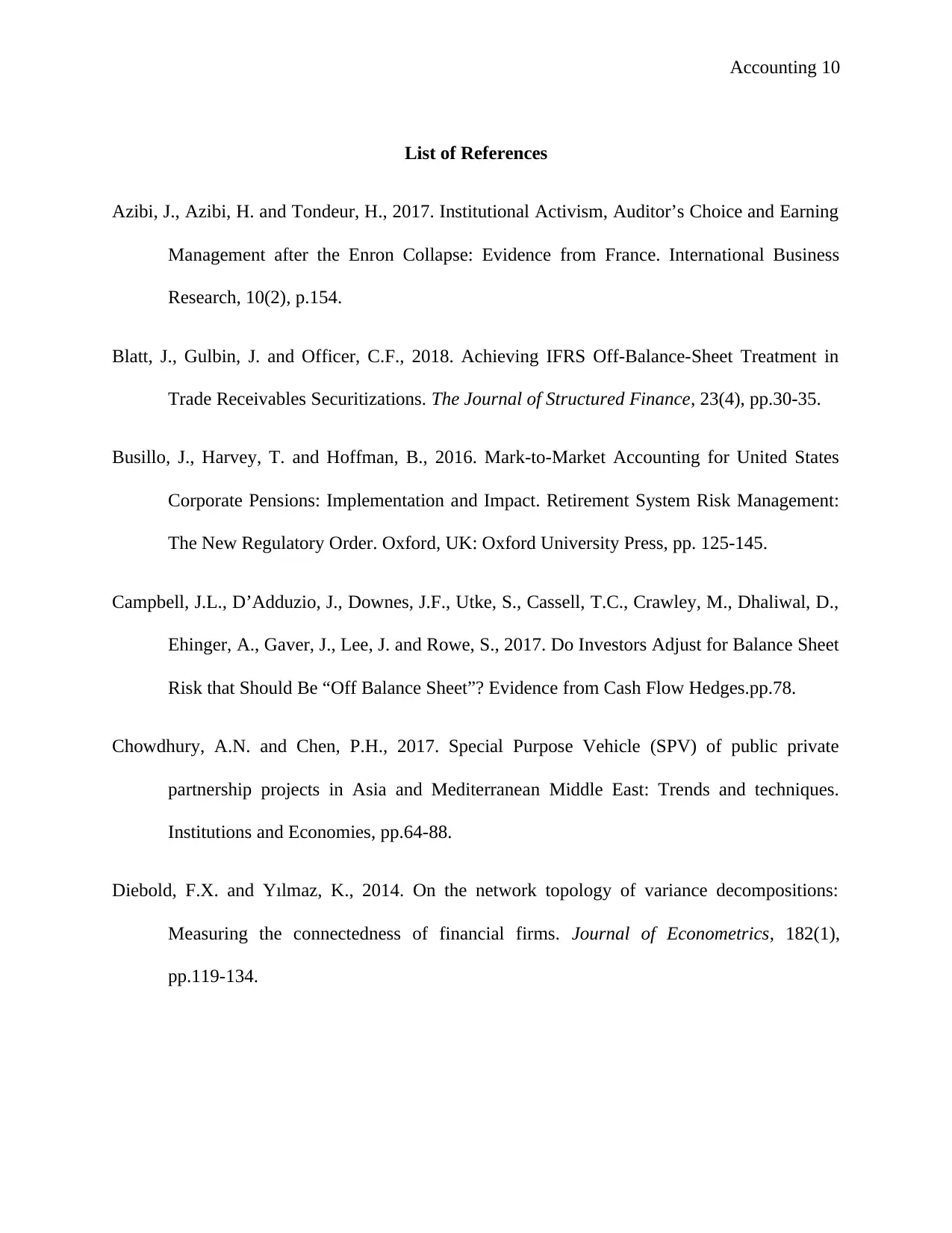
Accounting 10
List of References
Azibi, J., Azibi, H. and Tondeur, H., 2017. Institutional Activism, Auditor’s Choice and Earning
Management after the Enron Collapse: Evidence from France. International Business
Research, 10(2), p.154.
Blatt, J., Gulbin, J. and Officer, C.F., 2018. Achieving IFRS Off-Balance-Sheet Treatment in
Trade Receivables Securitizations. The Journal of Structured Finance, 23(4), pp.30-35.
Busillo, J., Harvey, T. and Hoffman, B., 2016. Mark-to-Market Accounting for United States
Corporate Pensions: Implementation and Impact. Retirement System Risk Management:
The New Regulatory Order. Oxford, UK: Oxford University Press, pp. 125-145.
Campbell, J.L., D’Adduzio, J., Downes, J.F., Utke, S., Cassell, T.C., Crawley, M., Dhaliwal, D.,
Ehinger, A., Gaver, J., Lee, J. and Rowe, S., 2017. Do Investors Adjust for Balance Sheet
Risk that Should Be “Off Balance Sheet”? Evidence from Cash Flow Hedges.pp.78.
Chowdhury, A.N. and Chen, P.H., 2017. Special Purpose Vehicle (SPV) of public private
partnership projects in Asia and Mediterranean Middle East: Trends and techniques.
Institutions and Economies, pp.64-88.
Diebold, F.X. and Yılmaz, K., 2014. On the network topology of variance decompositions:
Measuring the connectedness of financial firms. Journal of Econometrics, 182(1),
pp.119-134.
List of References
Azibi, J., Azibi, H. and Tondeur, H., 2017. Institutional Activism, Auditor’s Choice and Earning
Management after the Enron Collapse: Evidence from France. International Business
Research, 10(2), p.154.
Blatt, J., Gulbin, J. and Officer, C.F., 2018. Achieving IFRS Off-Balance-Sheet Treatment in
Trade Receivables Securitizations. The Journal of Structured Finance, 23(4), pp.30-35.
Busillo, J., Harvey, T. and Hoffman, B., 2016. Mark-to-Market Accounting for United States
Corporate Pensions: Implementation and Impact. Retirement System Risk Management:
The New Regulatory Order. Oxford, UK: Oxford University Press, pp. 125-145.
Campbell, J.L., D’Adduzio, J., Downes, J.F., Utke, S., Cassell, T.C., Crawley, M., Dhaliwal, D.,
Ehinger, A., Gaver, J., Lee, J. and Rowe, S., 2017. Do Investors Adjust for Balance Sheet
Risk that Should Be “Off Balance Sheet”? Evidence from Cash Flow Hedges.pp.78.
Chowdhury, A.N. and Chen, P.H., 2017. Special Purpose Vehicle (SPV) of public private
partnership projects in Asia and Mediterranean Middle East: Trends and techniques.
Institutions and Economies, pp.64-88.
Diebold, F.X. and Yılmaz, K., 2014. On the network topology of variance decompositions:
Measuring the connectedness of financial firms. Journal of Econometrics, 182(1),
pp.119-134.
Secure Best Marks with AI Grader
Need help grading? Try our AI Grader for instant feedback on your assignments.
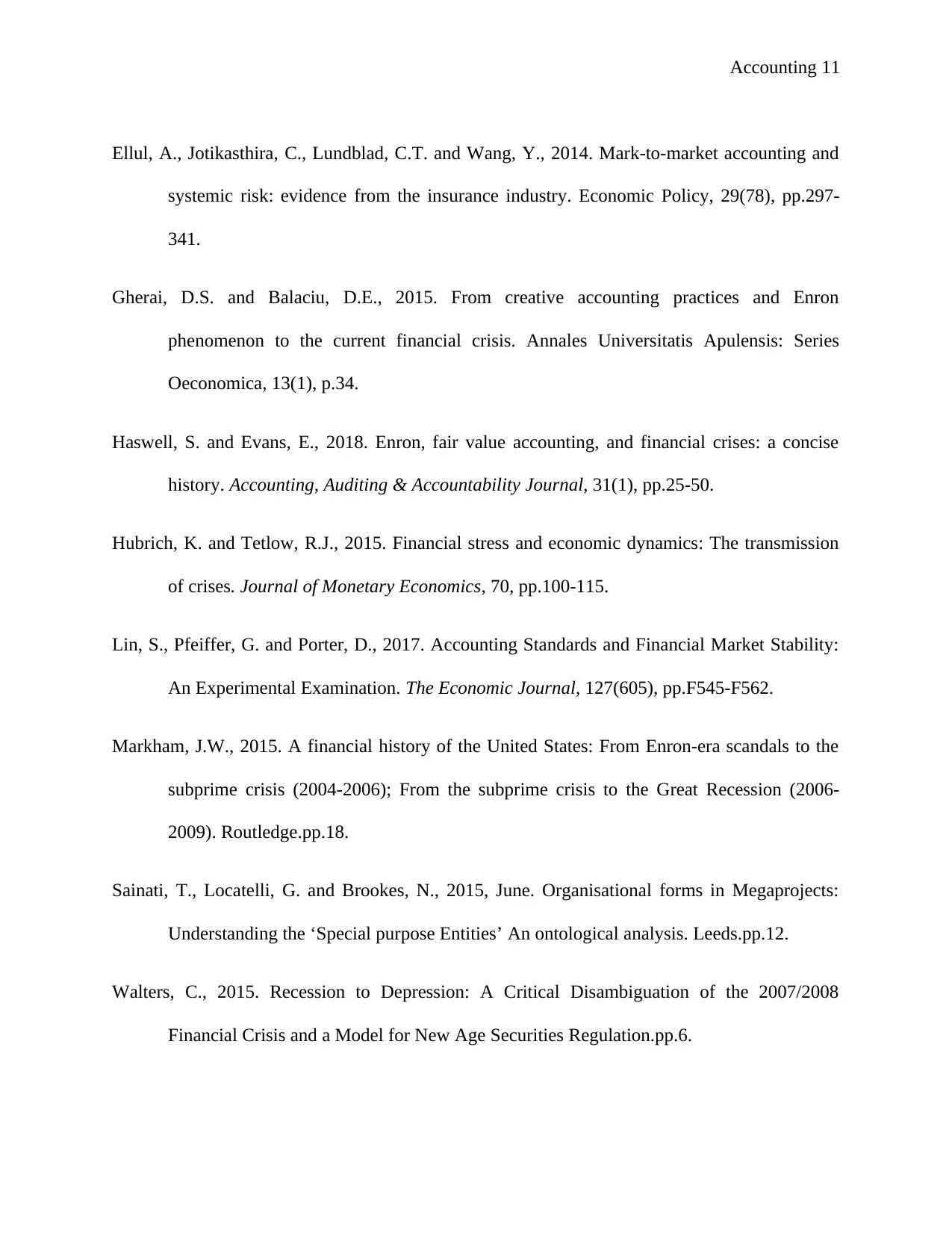
Accounting 11
Ellul, A., Jotikasthira, C., Lundblad, C.T. and Wang, Y., 2014. Mark-to-market accounting and
systemic risk: evidence from the insurance industry. Economic Policy, 29(78), pp.297-
341.
Gherai, D.S. and Balaciu, D.E., 2015. From creative accounting practices and Enron
phenomenon to the current financial crisis. Annales Universitatis Apulensis: Series
Oeconomica, 13(1), p.34.
Haswell, S. and Evans, E., 2018. Enron, fair value accounting, and financial crises: a concise
history. Accounting, Auditing & Accountability Journal, 31(1), pp.25-50.
Hubrich, K. and Tetlow, R.J., 2015. Financial stress and economic dynamics: The transmission
of crises. Journal of Monetary Economics, 70, pp.100-115.
Lin, S., Pfeiffer, G. and Porter, D., 2017. Accounting Standards and Financial Market Stability:
An Experimental Examination. The Economic Journal, 127(605), pp.F545-F562.
Markham, J.W., 2015. A financial history of the United States: From Enron-era scandals to the
subprime crisis (2004-2006); From the subprime crisis to the Great Recession (2006-
2009). Routledge.pp.18.
Sainati, T., Locatelli, G. and Brookes, N., 2015, June. Organisational forms in Megaprojects:
Understanding the ‘Special purpose Entities’ An ontological analysis. Leeds.pp.12.
Walters, C., 2015. Recession to Depression: A Critical Disambiguation of the 2007/2008
Financial Crisis and a Model for New Age Securities Regulation.pp.6.
Ellul, A., Jotikasthira, C., Lundblad, C.T. and Wang, Y., 2014. Mark-to-market accounting and
systemic risk: evidence from the insurance industry. Economic Policy, 29(78), pp.297-
341.
Gherai, D.S. and Balaciu, D.E., 2015. From creative accounting practices and Enron
phenomenon to the current financial crisis. Annales Universitatis Apulensis: Series
Oeconomica, 13(1), p.34.
Haswell, S. and Evans, E., 2018. Enron, fair value accounting, and financial crises: a concise
history. Accounting, Auditing & Accountability Journal, 31(1), pp.25-50.
Hubrich, K. and Tetlow, R.J., 2015. Financial stress and economic dynamics: The transmission
of crises. Journal of Monetary Economics, 70, pp.100-115.
Lin, S., Pfeiffer, G. and Porter, D., 2017. Accounting Standards and Financial Market Stability:
An Experimental Examination. The Economic Journal, 127(605), pp.F545-F562.
Markham, J.W., 2015. A financial history of the United States: From Enron-era scandals to the
subprime crisis (2004-2006); From the subprime crisis to the Great Recession (2006-
2009). Routledge.pp.18.
Sainati, T., Locatelli, G. and Brookes, N., 2015, June. Organisational forms in Megaprojects:
Understanding the ‘Special purpose Entities’ An ontological analysis. Leeds.pp.12.
Walters, C., 2015. Recession to Depression: A Critical Disambiguation of the 2007/2008
Financial Crisis and a Model for New Age Securities Regulation.pp.6.

Accounting 12
WoolworthsGroupAnnualReport;https://www.woolworthsgroup.com.au/icms_docs/
188795_annual-report-2017.pdf
Zreik, R., Latouche, P. and Bouveyron, C., 2015. Clustering of dynamic networks through
subgraphs: a study of the Enron scandal. JOURNAL OF THE SFDS, 156(3), pp.166-191.
WoolworthsGroupAnnualReport;https://www.woolworthsgroup.com.au/icms_docs/
188795_annual-report-2017.pdf
Zreik, R., Latouche, P. and Bouveyron, C., 2015. Clustering of dynamic networks through
subgraphs: a study of the Enron scandal. JOURNAL OF THE SFDS, 156(3), pp.166-191.
1 out of 12
Related Documents
Your All-in-One AI-Powered Toolkit for Academic Success.
+13062052269
info@desklib.com
Available 24*7 on WhatsApp / Email
![[object Object]](/_next/static/media/star-bottom.7253800d.svg)
Unlock your academic potential
© 2024 | Zucol Services PVT LTD | All rights reserved.




